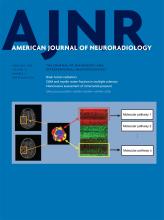Abstract
BACKGROUND AND PURPOSE: Uniform complete fat suppression is essential for identification and characterization of most head and pathology. Our aim was to compare the multipoint Dixon turbo spin-echo fat-suppression technique with 2 different fat-suppression techniques, including a hybrid spectral presaturation with inversion recovery technique and an inversion recovery STIR technique, in head and neck fat-suppression MR imaging.
MATERIALS AND METHODS: Head and neck MR imaging datasets of 72 consecutive patients were retrospectively reviewed. All patients were divided into 2 groups based on the type of fat-suppression techniques used (group A: STIR and spectral presaturation with inversion recovery gadolinium-T1WI; group B: multipoint Dixon T2 TSE and multipoint Dixon gadolinium-T1WI TSE). Objective and subjective image quality and scan acquisition times were assessed and compared between multipoint Dixon T2 TSE versus STIR and multipoint Dixon gadolinium-T1WI TSE versus spectral presaturation with inversion recovery gadolinium-T1WI using the Mann-Whitney U test.
RESULTS: A total of 64 patients were enrolled in the study (group A, n = 33 and group B, n = 31). Signal intensity ratios were significantly higher for multipoint Dixon T2 and gadolinium-T1WI techniques compared with STIR (P < .001) and spectral presaturation with inversion recovery gadolinium-T1WI (P < .001), respectively. Two independent blinded readers revealed that multipoint Dixon T2 and gadolinium-T1WI techniques had significantly higher overall image quality (P = .022 and P < .001) and fat-suppression grades (P < .013 and P < .001 across 3 different regions) than STIR and spectral presaturation with inversion recovery gadolinium-T1WI, respectively. The scan acquisition time was relatively short for the multipoint Dixon technique (2 minutes versus 4 minutes 56 seconds for the T2-weighted sequence and 2 minutes versus 3 minutes for the gadolinium-T1WI sequence).
CONCLUSIONS: The multipoint Dixon technique offers better image quality and uniform fat suppression at a shorter scan time compared with STIR and spectral presaturation with inversion recovery gadolinium-T1WI techniques.
ABBREVIATIONS:
- AP
- anteroposterior
- CHESS
- chemical shift selective suppression
- FS
- fat suppression
- Gad-T1WI
- gadolinium-T1WI
- mDixon
- multipoint Dixon
- SPIR
- spectral presaturation with inversion recovery
- © 2018 by American Journal of Neuroradiology












